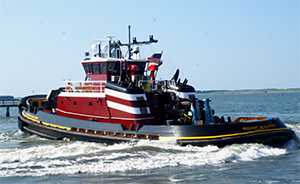On a sunny late summer morning, three ships lined the private coal terminals in Newport News, Va. At least a dozen more colliers waited their turn from a nearby anchorage.
Right on cue, two McAllister Towing tugboats arrived at Dominion Terminal Associates (DTA) to assist one ship off the pier and make room for another. The job itself was straightforward: The 623-foot Amoy Action, weighed down with Appalachian coal, would back off the terminal under its own power, and the tugs would help spin the bow toward open water.
Jobs like this one account for much of the ship-assist work in Hampton Roads, a thriving container port that’s also the nation’s busiest for coal exports. Demand for coal to produce steel and electricity has fallen sharply in the United States in the past decade, but the export market remains red-hot. Nowhere is that more evident than the three private terminals around Norfolk.
Data from T. Parker Host, a Norfolk-based shipping and logistics firm, shows the three coal piers owned by Kinder Morgan, DTA and Norfolk Southern are projected to move almost 40 million metric tons of coal in 2018. If those numbers hold through Dec. 31, it would represent a 28 percent jump over 2017 and would double the output from 2016.
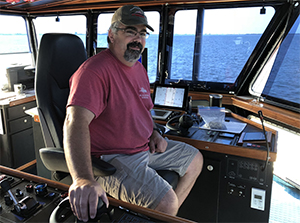 |
|
Capt. Christopher Hoffmann steers Rosemary McAllister across the Newport News Channel on the way to the Dominion Terminal Associates coal pier. He cites the tugboat’s stability as one of its best features. |
|
Casey Conley |
Norfolk Southern’s Pier 6 near downtown Norfolk handles about 40 percent of the region’s coal volume, followed closely by DTA and then Kinder Morgan. Pier 6 is the largest and fastest-loading coal terminal in the Northern Hemisphere.
“It’s been really good this year,” Ken Flowers, vice president and general manager for Moran Towing’s Norfolk operation, said of coal shipping. “We didn’t expect it to be this good.”
Rising coal exports coincide with a steady rise in container volumes at the Port of Virginia, and a similar decline in ship calls. Container activity jumped almost 12 percent between 2015 and 2017 to more than 1.6 million TEU, driven in part by regular stops by neo-Panamax ships. Yet over the same period, ship calls dropped almost 13 percent to 1,746 in 2017. Container volumes for 2018 were essentially flat through September, while port calls were off by about 5 percent.
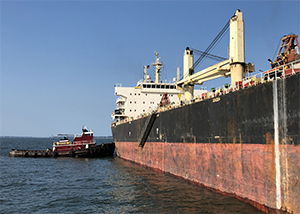 |
|
G.M. McAllister takes position on Amoy Action’s starboard quarter as the bulk carrier backs away from Pier 3 at Dominion. |
|
Casey Conley |
Moran Towing and McAllister Towing share commercial ship-assist work in Hampton Roads, and both built powerful, state-of-the-art tugboats to serve bigger containerships calling on the region. Judy Moran and Rosemary McAllister, both with 6,772 hp and Caterpillar Tier 4 engines, arrived last summer and went to work almost immediately.
Manning the helm of Rosemary McAllister, Capt. Christopher Hoffmann left Pier 3 at the Virginia International Terminal at about 0900 on Aug. 29 to assist Amoy Action off the DTA terminal. Chief engineer John Pannell and deck hand Henry Aguinaldo also were on duty. Two others were off watch.
Rosemary has proven itself time and again since delivery from Eastern Shipbuilding in Panama City, Fla. “It is hard to find a flaw in the boat,” Hoffmann said while crossing the harbor at 11 knots. “She is very versatile. She is beamy and she is stable. … It’s a McAllister tug on steroids.”
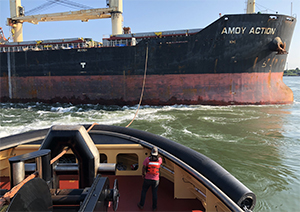 |
|
Deck hand Henry Aguinaldo monitors the line as Rosemary McAllister helps spin Amoy Action as it departs the Port of Virginia. |
|
Casey Conley |
Moran crews have had similarly positive reactions to the recently delivered Judy Moran, a sister tug to Benson George Moran, which was delivered in late 2017 by Washburn & Doughty. Moran’s Norfolk crews trained on Benson before it departed for Port Arthur, Texas, where it is now assigned, giving them time to get acclimated to the Tier 4 components and the additional horsepower.
“It’s turned out great for us because we had the opportunity to do a lot of training on the Benson, which helped us with the Judy,” Flowers said. “The guys tell me they like her a lot. It’s a little different in the wheelhouse. This design eliminated the vertical support posts behind the operator’s chair. Compared to the sister tug, it opens the space up. You get a feeling the wheelhouse is larger but the size has not actually changed. The crews are enjoying the tug, and the docking pilots have had nothing but positive comments on how she performs on ship jobs.”
Rosemary’s propulsion comes from twin Caterpillar 3516E Tier 4 diesel engines rated for 3,386 hp each paired with Schottel SRP4000 FP z-drives. Electrical power comes from three Cat C7.1 gensets each producing 118 kW. Jensen Maritime Consultants designed the tugboat series that includes lead boat Capt. Brian A. McAllister delivered in summer 2017, Rosemary McAllister, and two sister tugs currently under construction at Eastern Shipbuilding.
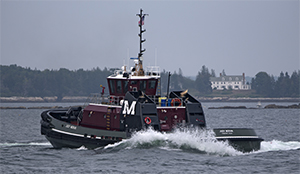 |
|
Judy Moran works colliers and large containerships in Hampton Roads, Va. Washburn & Doughty built the vessel in East Boothbay, Maine, where it is shown earlier in 2018. |
|
John Snyder photo/Courtesy Moran |
Rosemary reached the dock after an uneventful trip across the harbor. The 4,000-hp G.M. McAllister was already in position on the starboard quarter of Amoy Action when Rosemary arrived and came alongside the starboard bow. The bulk carrier’s crew dropped a messenger line to a waiting Aguinaldo, who secured it to the Samson Saturn-12 hawser line.
Before long, the collier began backing astern under the command of Capt. Tyler Moore of the Independent Docking Pilots. Initially, the pilot intended to keep the ship as close as possible to the pier while placing minimal pressure on the dock, Hoffmann explained. From there, it got a little more complicated.
“As the stern backs out, G.M. will pick it up (on the port side) and hold it into the current,” Hoffmann said. “Once it gets far enough out there, probably midship to the pier, G.M. won’t be able to hold it in the current, so we will start backing the bow around.”
Before long, Moore ordered Rosemary to back away from the ship to prepare for pulling the bow. “All right,” Hoffmann responded over the radio. “We’re stretched out and ready to work.”
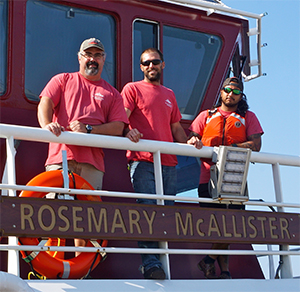 |
|
Although it can vary by the job, Rosemary McAllister typically operates with a three-person crew. From left are Capt. Christopher Hoffmann, chief engineer John Pannell and deck hand Henry Aguinaldo. |
|
Casey Conley |
Moore ordered the tug to back easy. Although Rosemary has 80 tons of bollard pull, the job required only about five. Amoy Action’s bow dutifully followed. Before long, the bow had spun about 50 degrees and faced south in the James River. The entire evolution lasted less than 15 minutes and required just a handful of pilot orders.
“Tyler is an excellent pilot,” Hoffmann said. “He gives very few commands and requires very little power. He controls the ship well.”
On a given day, Hoffmann and his crew will handle about six ships, but sometimes many more. Although ships carrying coal and containers account for much of the work, roll-on/roll-off (ro-ro) vehicle carriers and the occasional tanker also call around Hampton Roads. Roughly 12 hours earlier, Rosemary escorted a 13,000-TEU containership arriving at the Port of Virginia.
“I love working this port,” Hoffmann said. “It’s exciting, you’re getting the extra large vessels in, it’s always a challenge, and you get to do a little bit of everything.”
After Amoy Action left the port, Rosemary returned to Pier 3 in Norfolk for a crew change. The respite lasted only a few hours. Around lunchtime, another containership was scheduled to sail, and Rosemary McAllister would be ready.

